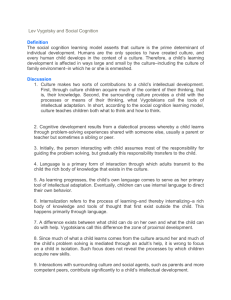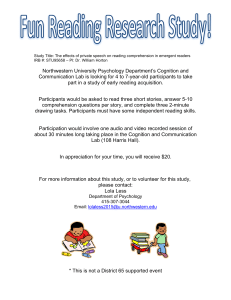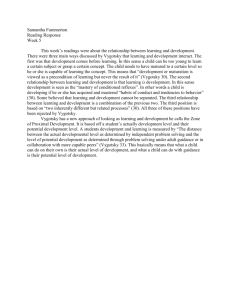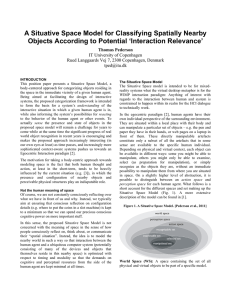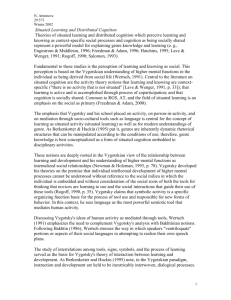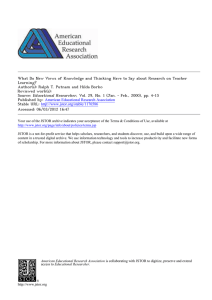The Situative Perspective in Educational Psychology
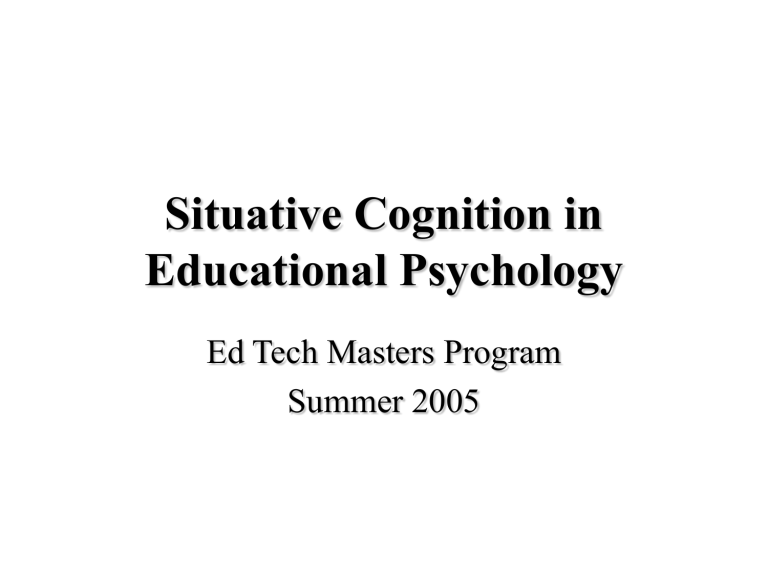
Situative Cognition in
Educational Psychology
Ed Tech Masters Program
Summer 2005
What is Situative Cognition?
• Also known as Situated, Sociohistoric or
Socicultural.
• The fields of ethnography, sociolinguistics, anthropology, and sociology contributed to this perspective.
• Learning is tied to the context or situation, students’ culture shapes their cognitive development, learning is highly social.
What is Situative Cognition? II
• Situative cognition focuses more on the social rather than the individual as cognitive psychology tends to do; All learning is social.
• “Views knowledge as distributed among people and their environments, including the objects, artifacts, tools, books, and the communities of which they are a part.” –
Greeno, Collins, & Resnick, 1996
Lev Vygotsky
(1896 – 1933)
A Russian psychologist, Vygotsky worked in the post-revolutionary
Soviet Union to rebuild psychology along Marxist lines. He worked to apply psychology to the problems confronting the new state, especially in the field of ed psych. Vygotsky’s writings were banned in the Soviet Union in 1936 and only became available in the west in the 1960’s at which point they became highly influential.
Vygotsky Continued
• Unlike Piaget’s image of the individual constructing understanding alone, Vygotsky saw cognitive development as depending more on interactions with the people and tools in the child’s world.
– Tools are real : pens, paper, computers; or symbols : language, math systems, signs
...and more Vygotsky
• Vygotsky developed the theory of the
Zone of proximal development (zoped)
– The zoped is the distance between where a learner is at developmentally on their own and where a learner could be with the help of a
more knowledgeable other.
– A more knowledgeable other can be an adult or a peer, helping a learner in this way is to scaffold their learning.
A Little on Learning
•
Two main elements of learning in situated cognition:
1. All learning is social and happens within a community through participation.
2. Learning is tied to its situation or context.
More on Learning
• Learning occurs through participation in a group, all learning is social.
– New participants initially observe and participate peripherally, as they gain experience they become more central participants.
– This is an apprentice approach to learning.
– “Cognitive apprenticeship” –
Collins, Brown, &
Newman (1989)
…and more on Learning
• Collins (1988) defines situated learning as
“the notion of learning knowledge and skills in contexts that reflect the way the knowledge will be useful in real life”
• Examples of situated learning:
– Lave’s weight watcher & cottage cheese
– Lave’s homemaker’s grocery store math
– Brazilian street kids’ math when making sales on the street
Transfer
• According to situated cognition, knowledge does not transfer between tasks.
• Teaching through abstraction is of little use since real learning occurs in authentic situations only
– Ex: New police academy grads being told by experienced cops “now forget everything you learned”.
More on Transfer
• If learning is being able to participate in a community of practice, the issue of transfer can be problematic.
– Does transfer apply to new practices within a community (e.g. new math problems) or to practices outside the community (e.g. work) ?
• Many resources and supports in one community don’t carry over to a different community.
Motivation
• The situative view emphasizes how people’s identities are formed by their participation in a group.
– According to this way of thinking, students can be motivated to learn by participating in communities where learning is valued.
– Ex: Children want to learn to read and write to become members of the “literary club”, to be able to participate and interact with the written world.
Critiques of Situative Cognition
• While the theory takes into account the social, the individual tends to be ignored.
• Transfer is problematic since knowledge doesn’t transfer between tasks.
• The theory can’t account for learning through abstraction or generalization (most school learning)
Situative Cognition in Education
• Knowing how to participate in social practices has a large role in schools.
– Classroom activities are often organized as social groups and children participate in these groups with varying degrees of success.
– Much of students’ identities are formed by the groups they participate in at school, e.g. sports, chess, journalism, A.P. classes ...
Situative Cognition in Education II
• A push for “authentic learning” where students learn content matter that is situated in a real world context (ex: Resnick article)
– Students are encouraged to think and work like scientists, historians, mathematicians, etc.
– Authentic does not necessarily mean “real world” but rather tasks that are “true” to the domain
• Encouraging classrooms to create a community of learning that promotes inquiry and development of identities.

